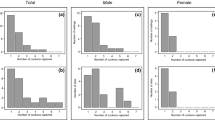Abstract
We analysed the spatial and temporal pattern of egg laying in great spotted cuckoo females using microsatellite typing to determine parentage of the eggs and nestlings found in host (magpie) nests. The results showed that there were no exclusive laying territories in the study area. Cases of multiparasitism could be due to single females laying two or more eggs in a nest, or to several females using the same nest. In the latter case multiparasitism was due to a shortage of available host nests. We argue that the need for very large laying areas and the likely small cost of sharing parental care for chicks make the costs of defending territories higher than the benefits, which has constrained the evolution of territoriality in this species.
Similar content being viewed by others
Author information
Authors and Affiliations
Additional information
Received: 16 March 1998 / Accepted: 15 June 1998
Rights and permissions
About this article
Cite this article
Martínez, J., Soler, J., Soler, M. et al. Spatial patterns of egg laying and multiple parasitism in a brood parasite: a non-territorial system in the great spotted cuckoo (Clamator glandarius). Oecologia 117, 286–294 (1998). https://doi.org/10.1007/s004420050660
Issue Date:
DOI: https://doi.org/10.1007/s004420050660




